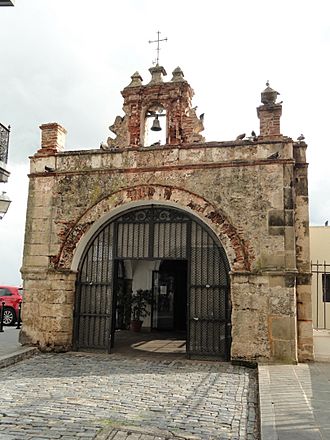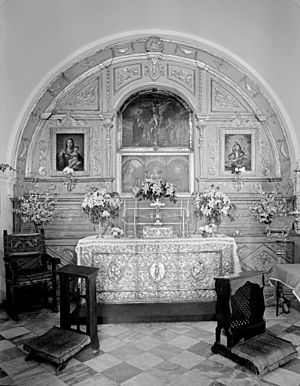Capilla del Cristo facts for kids
Quick facts for kids Chapel of the Christ |
|
|---|---|
|
Capilla del Santo Cristo de la Salud
|
|

Capilla del Cristo at the end of a cobblestone street
|
|
| Alternative names | Capilla del Cristo |
| General information | |
| Architectural style | Baroque |
| Town or city | Old San Juan |
| Coordinates | 18°27′50.7″N 66°07′03.9″W / 18.464083°N 66.117750°W |
| Construction started | 1753 |
| Estimated completion | 1780 |
| Owner | Catholic Church |
| Technical details | |
| Material | Masonry |
| Floor count | 1 |
| Design and construction | |
| Engineer | Juan Francisco Mestre |
| Known for | Folklore, historic architecture |
|
Capilla del Cristo
|
|
|
U.S. National Historic Landmark District
Contributing Property |
|
| Part of | Old San Juan Historic District (ID72001553) |
| Designated NHLDCP | October 10, 1972 |
The Capilla del Cristo (which means Chapel of Christ) is a small, historic chapel and museum in Old San Juan, Puerto Rico. It's also known as Capilla del Santo Cristo de la Salud. This special building was constructed in the 1700s. It was almost torn down in the 1900s but was saved and kept safe. Today, it's a very important cultural icon for Puerto Rico. Many of the items on its altar are from 1753. Travel guides often suggest visiting the Capilla del Cristo as a must-see spot in Old San Juan.
Contents
Why the Chapel is Special
The chapel, with its bell tower, sits at the very end of Calle del Cristo. This street is a walking path in the Old San Juan Historic District. The district is located on the western side of the San Juan Islet. Pictures of the chapel's front are very popular. You can often see them on travel guides for Puerto Rico. They also appear on posters, canvas prints, and even souvenir mugs.
Inside the chapel, you can find paintings by Jose Campeche. There is also a painting by Jorge Sen called El Milagro, which means "The Miracle." The chapel's altar is made of shiny silver and gold.
An annual festival called the St. Juan and St. Peter races (Las carreras de S. Juan y S. Pedro) has taken place near the chapel. This festival has been happening on Cristo Street since before the mid-1800s.
Where to Find the Chapel
The Capilla del Cristo is located at the end of Calle del Cristo. This is in the Historic District of Old San Juan. It's also close to La Fortaleza, which is where the governor of Puerto Rico lives.
How the Chapel Was Built
The main part of this small chapel is made of stone and brick. These materials are held together with mortar or cement. It is a one-story building. It has a curved bell tower on top. A gate was added in the 1940s to protect the inside of the chapel.
The chapel has three large arches. These arches open up to Parque de Palomas (Pigeon Park), Tetuan Street, and Calle de Cristo de la Salud. The chapel was built in the Spanish Baroque style. Juan Francisco Mestre, from Extremadura, Spain, designed it. A group of volunteers called the Cristo de la Salud Brotherhood helps keep the building in good condition.
The Chapel's Story and Legends
There's a famous story, especially among Catholic people, about the chapel. It says that during a horse race on La Calle de Cristo, a young rider and his horse had a terrible fall. The rider supposedly went over a cliff but was saved in a miraculous way.
The chapel was built right where this accident was said to have happened. It was built to honor the young rider, whose name was Baltazar Montañez. Today, the chapel is a popular spot for tourists. It's also a place where religious people, called pilgrims, visit. They sometimes leave a religious offering at the chapel. The chapel is only open to visitors on Tuesdays.
Different versions of the legend exist. Some say the rider himself called for help from above. Others say it was an observer named Tomas Mateo Pratts who yelled for divine help. In a book about Puerto Rican legends, José Ramirez-Rivera wrote that the horse died, but Baltazar lived. After this event, permission was given to build the Catholic chapel. Festivals were held for many years to celebrate this miracle.
A Puerto Rican historian named Cayetano Coll y Toste wrote about Baltazar. He described Baltazar as a slave who worked in the sugar cane fields of Puerto Rico. However, he did not mention the legendary accident in his writings.
Images for kids
See also










